The Moon in Evening Spells L-O-V-E, Some Illumination Rumination, Noctilucent Cloud Season, and Titan Travels Saturn in Morning

I captured this handheld smartphone image of the young crescent moon and the strong auroral display of May 10, 2024 behind my home in Collingwood, Ontario, Canada. Conditions are again favorable for another spectacle if the sun sends a mass ejection in our direction over the next few days, before the moon brightens too much.
Hello, mid-June Stargazers!
Here are your Astronomy Skylights for the week of June 9th, 2024 by Chris Vaughan. Feel free to pass this along to your friends and send me your comments, questions, and suggested topics. I repost these emails with photos at http://astrogeo.ca/skylights/ where the old editions are archived. You can also follow me on Twitter as @astrogeoguy! Unless otherwise noted, all times are expressed in Eastern Time. To subscribe to these emails please click this MailChimp link.
If you’d like me to bring my Digital Starlab portable inflatable planetarium to your school or other daytime or evening event in Simcoe, Grey, and Bruce Counties, or deliver a virtual session anywhere, contact me through AstroGeo.ca, and we’ll tour the Universe, or the Earth’s interior, together! My book with John A. Read entitled 110 Things to See With a Telescope is a guide to viewing the deep sky objects in the Messier List – for both beginners and seasoned astronomers. DM me to order a signed copy!
This will be the best week of the month to view our natural satellite in the evening, so I share some thoughts about phases – on the moon and planets. The waxing moon will spell L-O-V-E on Thursday night. With the solstice approaching, it’s the season to watch for Noctilucent clouds. Saturn leads the parade of pre-dawn planets and sports the spot of its biggest moon Titan on Friday morning in the Americas. Read on for your Skylights!
Noctilucent Clouds
The period from late May to mid-August, and especially around the June Solstice, which arrives next week, is the best time for mid-Northern latitude observers to watch for noctilucent clouds (NLC) in the hours before sunrise and after twilight, especially when there is no bright moonlight. Those are very high clouds that form in the mesosphere layer of Earth’s atmosphere, 80-82 km above the ground. That’s high enough to catch and reflect sunlight while conditions are dark at ground level. Another name for them is polar mesospheric clouds (PMC).
The clouds form when very cold water vapour that develops in the stratosphere diffuses upwards and freezes around meteor dust particles that are descending from space. The mesosphere is coldest around the solstice. Visually, the clouds will appear as bright, cirrus-like ripples across the lower third of the northern sky, often tinted a silver-blue. If you see dark wisps of clouds overhead, those are regular cirrus clouds.

as seen from Edmonton, Alberta. Photo by RASC member Alister Ling
According to this terrific article from RASC, the first cloud sightings in North America were reported in 1933. The phenomenon may be increasing in frequency as climate change alters the upper atmosphere. More information, and a current polar map of the NLC coverage, can be viewed down the left-hand column of www.spaceweather.com. If you see them, or photograph them, tag me!
The Moon, Some Illumination Rumination, and L-O-V-E
Earth’s natural satellite will be shining after sunset all week – giving moon-lovers worldwide their best show of the month.
Non-stellar objects like the moon, the planets, and the asteroids don’t emit light. They are only visible to us because the sun is shining on them and some of that light is reflected in our direction. The brightness we perceive increases if they are closer to us (as Mars occasionally becomes), larger (like Jupiter), and more reflective (as Venus’ clouds are). Comets are a special case because the warmth and radiation of the sun causes their “dirty snowballs” to discharge gases that glow in a coma around them, whereas comet tails appear when sunlight reflected and scattered off of the small particles tossed out as it travels – the “dirt” is released as the “snow” sublimates. (There’s no melting in space.)
For a spherical object like the moon or a planet, sunlight is always lighting up half of it (one full hemisphere), leaving the other half dark. The amount of the lit hemisphere that we see from Earth varies as the angle between the sun, that object, and us, changes. We can see 100% of its lit hemisphere (as during a full moon), most of its lit hemisphere (as during a gibbous moon), or only a bit of the lit hemisphere (as during a crescent moon) – and every stage in between. When the moon is new, all of the side pointing away from Earth is lit up and all of the side facing us is dark. We call these varying amounts of illumination phases, often expressed in the percentage lit.
Whenever solar system objects are closer to the sun than us, they display crescent phases. That includes the moon during about half of its monthly orbit around Earth, and also Venus and Mercury during the periods when they are closer to us than the sun. Those two inner planets are visible with a gibbous phase in a telescope while they are travelling the halves of their orbits that are farther from us than the sun is (i.e., the far side of the solar system). We rarely see Venus or Mercury when they are 100% full because they are then very close to the sun in the sky. The outer planets that orbit farther from the sun than we do, can show phases, too. Mars can be as little as 88%-illuminated, as it will be during evening come September. Jupiter can drop to 99%-lit, but the more distant planets always look close to 100% full.
The boundary between the lit and dark hemisphere on a planet or moon is called the terminator. It actually demarks the locations on that object where the sun is rising, or setting. When you experience sunrise or sunset, the Earth’s terminator is sweeping past you. On your tropical vacation near the Earth’s equator, the terminator races over you at a whopping 1,675 km/hr. At middle latitudes (north or south), that reduces to a mere 1,280 km/hr. Near the Earth’s poles, the rate drops to a speed you could keep up with on your snowshoes!
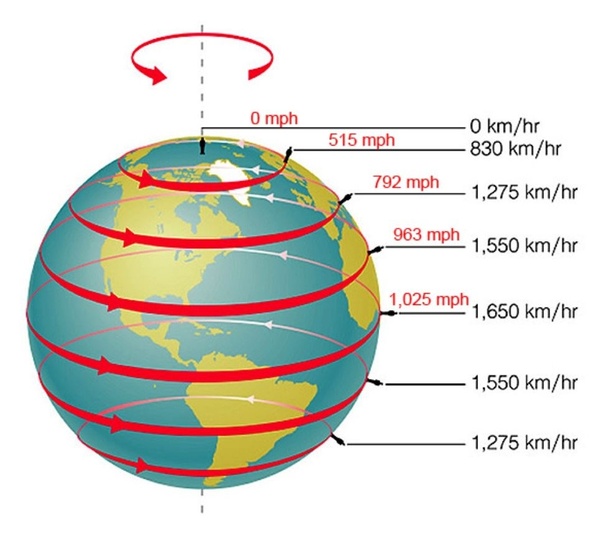
On the evenings after new moon each month, the terminator on the moon is strongly curved, its tips affixed to the moon’s north and south poles. As the moon crosses the sky from east to west, you’ll notice that the two ends of the terminator tip over – proof that we are viewing it from the surface of a rotation spherical Earth. (Everything tilts as it crosses the sky – moon, planets, and constellations, etc.)
As the angle between the sun and moon increases each night, the moon waxes in phase and the terminator slides west across the lunar surface (at less than 15 km per hour). When the moon reaches its first quarter phase, as it will on Friday morning, the 90 degree angle formed by the Earth, sun, and moon at that time will cause us to see our natural satellite half-illuminated on its eastern side. The terminator will temporarily become a straight line, and then it will curve more and more the other way. That’s how the ancients knew that the moon was a sphere!
Since the terminator marks where the sun is rising, the lunar terrain on the sunny side of it is being lit by nearly horizontal rays of sunlight. Every little bump, hill, crater rim, ridge, and mountain peak will cast shadows to the west – producing breathtaking vistas through binoculars or a backyard telescope. With no atmosphere to scatter the light, the shadows are inky black. Watch for crater floors that are fully dark or partially lit. Tall peaks on the dark side of the terminator will catch the sun first. Since the terminator is in constant motion, the views changes hour-by-hour and night-by-night. So check back regularly! The shape of the shadow on the crater floor tells us the depth profile of the crater – bowl-shaped or pie-pan – and the length of shadows tell us how tall the peaks are!
At this part of the lunar month, the moon is rising in the daytime and chasing the sun across the sky. Today (Sunday) the moon will rise around 8 am local time, but its slender, 13%-illuminated crescent won’t be that easy to see until the sky begins to darken after sunset. Watch for Earthshine on the moon on the next evening or two. Sometimes called the Ashen Glow or the Old Moon in the New Moon’s Arms, the phenomenon, which was first explained by Leonardo da Vinci in the 16th century, is visible within a day or two of new moon, when sunlight reflected off Earth and back toward the moon slightly brightens the unlit portion of the moon’s Earth-facing hemisphere.
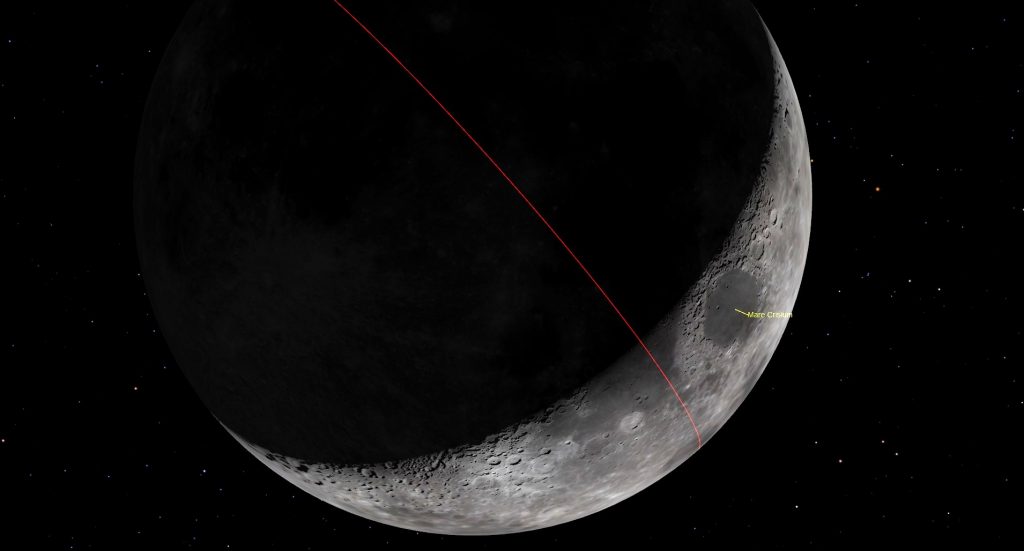
The dark oval of Mare Crisium will be framed within the moon’s crescent. Once the stars come out, the bright fraternal twin stars of Gemini, Castor and Pollux, will sparkle a fist’s diameter to the lower right of the moon. The moon itself will be in Cancer (the Crab) for Sunday and Monday.
As this week wears on, the moon will linger about 25 minutes longer each evening and wax in phase. Tuesday’s moon will shine near Regulus, the brightest star in Leo (the Lion). The moon will travel through Leo until it slips into Virgo (the Maiden) for the coming weekend. The moon will complete the first quarter of its orbit around Earth, measuring from the previous new moon, on Friday, June 14 at 1:18 am EDT and 05:18 GMT, which converts to 10:18 pm PDT on Thursday night.
Several times a year, for a few hours near its first quarter phase, a feature on the moon called the Lunar X becomes visible in powerful, tripod-mounted binoculars and backyard telescopes. The X will appear late on Thursday evening, June 13 in the Americas! When the rims of the craters Purbach, la Caille, and Blanchinus are illuminated from a particular angle by the sun, they form a small, but very obvious X-shape. The phenomenon is an example of pareidolia – the tendency of the human mind to see familiar objects when looking at random patterns. The Lunar X is located near the terminator, about one third of the way up from the southern pole of the moon (at lunar coordinates 2° East, 24° South). A prominent round crater named Werner sits to its lower right (or lunar southeast).
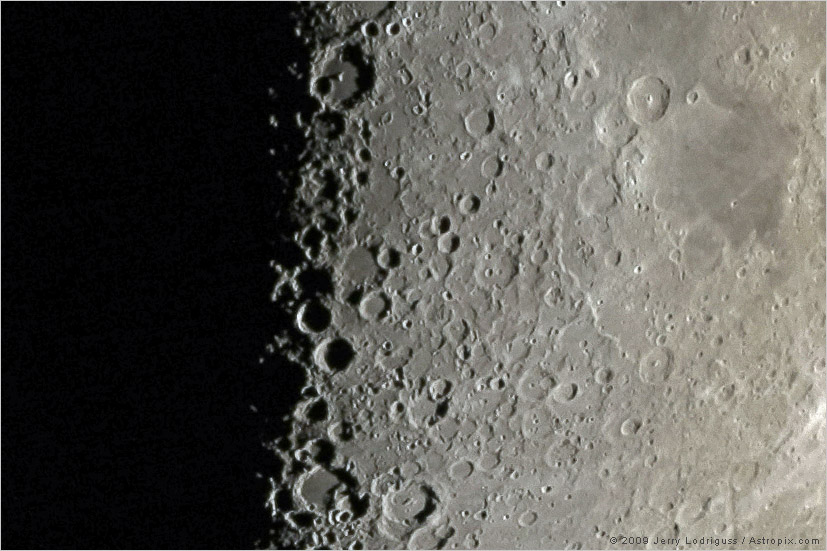
When the sun’s light first touches those craters the X will be indistinct. The shape will intensify to peak visibility by about midnight Eastern Time on Thursday night, and then fade when the surrounding terrain becomes illuminated an hour or two later. The pattern will be visible anywhere on Earth where the moon is shining, especially in a dark sky, between about 02:00 and 06:00 Greenwich Mean Time on June 14.
During a Lunar X event, you can also look for the Lunar V and the Lunar L. The “V” is produced by combining the small crater named Ukert with some ridges to the east and west of it. It is located a short distance above the moon’s equator at lunar coordinates 1.5° East, 8° North. For a further challenge, see if you can see the letter “L” down near the moon’s southern pole. Its position is to the southwest of three prominent and adjoining craters named Licetus, Cuvier, and Heraclitus, which resemble Mickey Mouse’s head and ears. Some people claim they can see a letter-E on the moon during the Lunar X period, too. Then, by picking a round crater along the terminator to serve as the “O”, you can spell L-O-V-E! While you are looking at the moon, watch for subtle wrinkles snaking across the lit parts of Mare Imbrium, the giant basin in the northern portion of the moon.
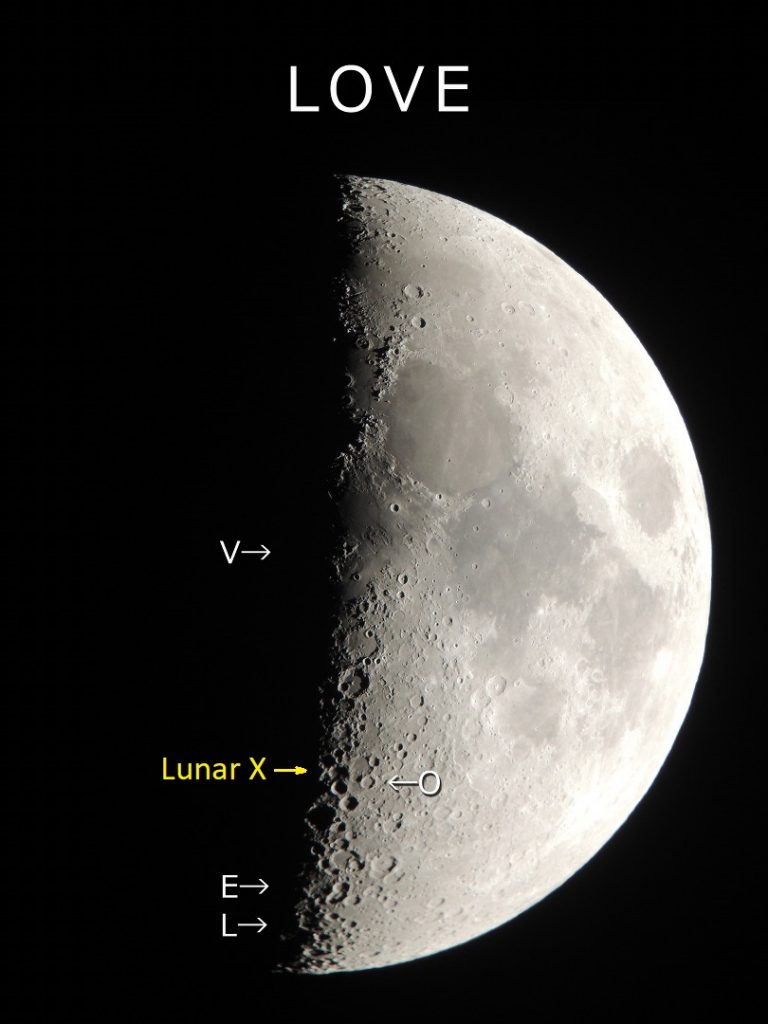
Next Sunday afternoon, June 16 in the Americas, the bright, 76%-illuminated, waxing gibbous moon will rise in mid-afternoon and ascend the southeastern sky until dusk. Once the sky darkens in late evening, look for Virgo’s brightest star Spica twinkling several finger widths to the moon’s right (or 3° to its celestial WNW). Spica is a hot, white, B1-class star 250 light-years away from our sun. Hours earlier, skywatchers located in the region northeast of the Black Sea can use binoculars and backyard telescopes to watch the moon cross in front of (or occult) Spica.
The Planets
We have another full month to wait before Saturn starts to become visible before midnight. Mercury will appear over the western horizon after sunset in the final week of June, and Venus will begin an eight-month stint as the “evening star” as July begins. For now, you’ll need to head outside between the wee hours and dawn if you want to see a planet.
This week, the medium-bright, yellowish dot of Saturn will rise around 1:30 am local time and then clear the rooftops in the east about an hour later. You’ll be able to see Saturn until almost sunrise. The planet will spend the next 10 months wandering through the stars of eastern Aquarius (the Water-Bearer) Binoculars will show you an up-down row of five stars to Saturn’s right (celestial west). The lower down trio named Psi1,2,3 Aquarii (or ψ1,2,3 Aqr) are blue-white in colour. Several more golden-coloured stars are spread out above them.

Saturn’s rings, which will effectively disappear when they become edge-on to Earth next March, already look very narrow against the planet’s globe. Good binoculars can hint at Saturn’s rings and any telescope will show them. For telescope-owners, Earth’s perspective of the Saturn system this year and next will produce frequent transits of Saturn’s moons and their black shadows across its disk. On Friday morning, folks with good quality telescopes can watch Saturn’s largest moon, named Titan, cross the southern part of Saturn’s globe starting at 4:50 am EDT or 08:50 GMT. Observers located in westerly time zones can watch the moon cross until 6:10 am PDT or 10:10 GMT. Titan’s shadow will also be visible during most of the same period.
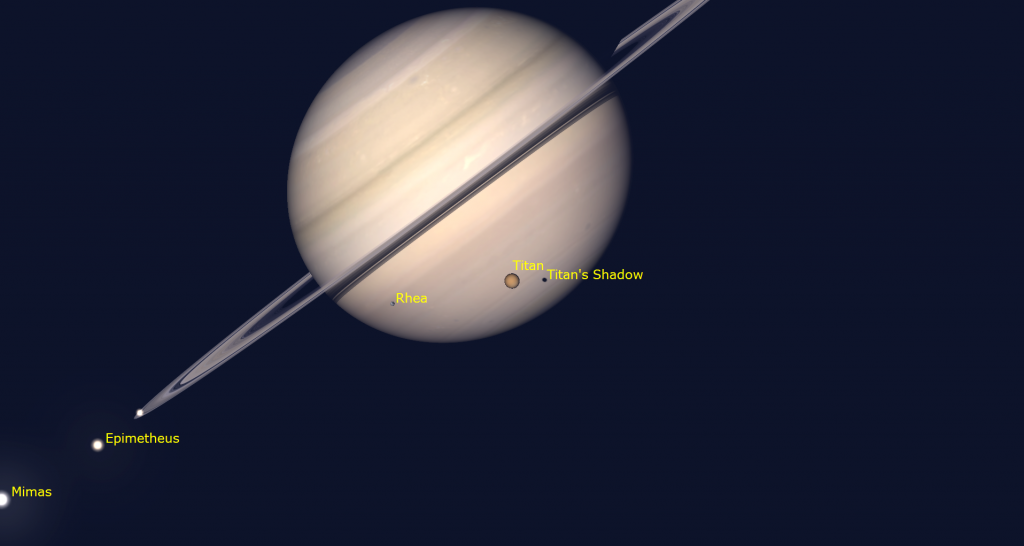
The next planet to rise will be distant Neptune. The blue planet will spend this year in western Pisces (the Fishes), a generous fist’s width to the lower left (or 11° to the celestial ENE) of Saturn. Neptune will also be located a bit more than a thumb’s width to the upper left (or 2° north) of a medium-bright star named 27 Piscium. They’ll share the view in binoculars. Other less-brilliant stars nearby named 29 Piscium, 24 Piscium, and 20 Piscium will help guide you to Neptune with a backyard telescope or good, strong binoculars.
Reddish Mars will rise by 4 am local time. If the sky is still dark, the brightest stars of Aries (the Ram) will twinkle to Mars’ upper left. Mars will look a little brighter than Saturn, making their colour-contrasted duo your best bet for pre-dawn planet viewing. The Great Square of Pegasus asterism will sparkle above and between Mars and Saturn. In a telescope, Mars will display a small, ruddy disk. Its position on the far side of the sun from Earth will keep the planet looking small until later this year.

Although Uranus will rise next, at about 4 am, the brightening sky will hide the planet. If you have an unobstructed horizon towards the ENE, though, you might glimpse far brighter Jupiter after it rises around 4:35 am local time. Be sure to turn all optical aids away from the eastern horizon before the sun rises.
The inner planets Venus and Mercury will be completely hidden by the sun’s glare.
Public Astronomy-Themed Events
Every Monday evening, York University’s Allan I. Carswell Observatory runs an online star party – broadcasting views from four telescopes/cameras, answering viewer questions, and taking requests! Details are here. They host in-person viewing on the first clear Wednesday night each month. Other Wednesdays they stream views online via the observatory YouTube channel. Details are here.
Taking advantage of the crescent moon in the sky this week, the RASC Toronto Centre astronomers will hold their monthly City Sky Star Party in Bayview Village Park (a short walk from the Bayview TTC subway station), starting after dusk on the first clear weeknight this week (Mon, Tue or Thu only). Check here for details, and check the banner on their website home page or Facebook page for the GO or NO-GO decision around 5 pm each day
Eastern GTA sky watchers are invited to join the RASC Toronto Centre and Durham Skies for solar observing and stargazing at the edge of Lake Ontario in Millennium Square in Pickering on Friday evening, June 14, starting at 7 pm. Details are here. Before heading out, check the RASCTC home page for a Go/No-Go call – in case it’s too cloudy to observe.
On Saturday, June 15 from 10 pm to midnight, RASC Toronto Centre will host Family Night at the David Dunlap Observatory for visitors aged 7 and up. You will tour the sky, visit the giant 74” telescope, and view celestial sights through telescopes if the sky is clear. This program runs rain or shine. Details are here, and the link for tickets is at ActiveRH.
Space Station Flyovers
The ISS (or International Space Station) will not be visible gliding silently over the Greater Toronto Area this week.
Keep your eyes on the skies! I love getting questions and requests. Send me some!